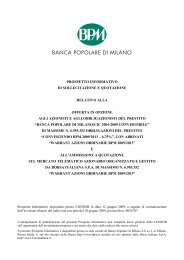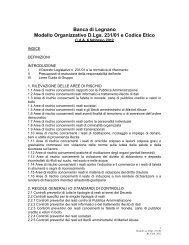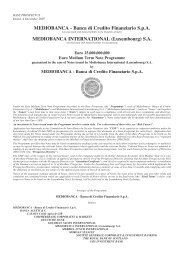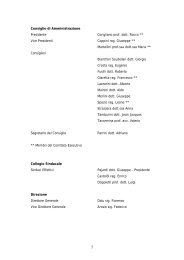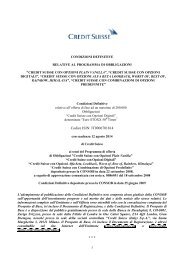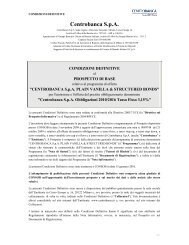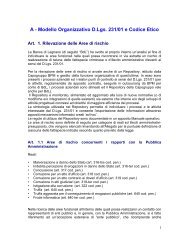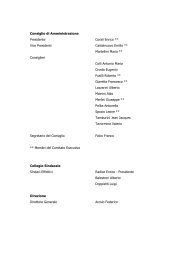INDEX OF DEFINED TERMS - Banca di Legnano
INDEX OF DEFINED TERMS - Banca di Legnano
INDEX OF DEFINED TERMS - Banca di Legnano
You also want an ePaper? Increase the reach of your titles
YUMPU automatically turns print PDFs into web optimized ePapers that Google loves.
Level: 2 – From: 2 – Wednesday, July 21, 2010 – 14:35 – eprint6 – 4247 Section 03<br />
Regulatory Matters<br />
4. Distributions<br />
The Issuer’s funds for cash <strong>di</strong>stributions to its stockholders and payment of the Issuer’s<br />
indebtedness, inclu<strong>di</strong>ng debt securities, are derived from a variety of sources, inclu<strong>di</strong>ng cash and<br />
temporary investments. The primary source of such funds, and funds used to pay principal and interest on<br />
its indebtedness, is <strong>di</strong>vidends received from its banking subsi<strong>di</strong>aries. Each of its banking subsi<strong>di</strong>aries is<br />
subject to various regulatory policies and requirements relating to the payment of <strong>di</strong>vidends, inclu<strong>di</strong>ng<br />
requirements to maintain capital above regulatory minimums. The appropriate federal regulatory authority<br />
is authorized to determine under certain circumstances relating to the financial con<strong>di</strong>tion of a bank or bank<br />
hol<strong>di</strong>ng company that the payment of <strong>di</strong>vidends would be an unsafe or unsound practice and to prohibit<br />
payment thereof.<br />
In ad<strong>di</strong>tion, the ability of the Issuer and its banking subsi<strong>di</strong>aries to pay <strong>di</strong>vidends may be affected<br />
by the various minimum capital requirements and the capital and non-capital standards established under<br />
FDICIA, as described above. The right of the Issuer, its stockholders, and its cre<strong>di</strong>tors to participate in any<br />
<strong>di</strong>stribution of the assets or earnings of its subsi<strong>di</strong>aries is further subject to the prior claims of cre<strong>di</strong>tors of<br />
the respective subsi<strong>di</strong>aries.<br />
5. Source of Strength<br />
Accor<strong>di</strong>ng to Federal Reserve Board policy, bank hol<strong>di</strong>ng companies are expected to act as a source<br />
of financial strength to each subsi<strong>di</strong>ary bank and to commit resources to support each such subsi<strong>di</strong>ary. This<br />
support may be required at times when a bank hol<strong>di</strong>ng company may not be able to provide such support.<br />
Similarly, under the cross-guarantee provisions of the Federal Deposit Insurance Act, in the event of a loss<br />
suffered or anticipated by the FDIC, either as a result of default of a banking subsi<strong>di</strong>ary or related to the<br />
FDIC assistance provided to a subsi<strong>di</strong>ary in danger of default, the other banking subsi<strong>di</strong>aries of a bank<br />
hol<strong>di</strong>ng company may be assessed for the FDIC’s loss, subject to certain exceptions.<br />
6. Deposit Insurance<br />
Deposits placed at the Issuer’s U.S. banking subsi<strong>di</strong>aries are insured by the FDIC subject to limits<br />
and con<strong>di</strong>tions of applicable law and the FDIC’s regulations. In 2009, FDIC insurance coverage limits<br />
were temporarily increased from $100,000 to $250,000 per customer until December 31, 2013. The FDIC<br />
administers the Deposit Insurance Fund (the “DIF”), and all insured depository institutions are required to<br />
pay assessments to the FDIC that fund the DIF. Assessments are required if the ratio of the DIF to insured<br />
deposits in the United States falls below 1.15 per cent. As a result of the ongoing instability in the<br />
economy and the failure of other U.S. depository institutions, the DIF ratio currently is below the required<br />
level and the FDIC has adopted a restoration plan that will result in substantially higher deposit insurance<br />
assessments for all depository institutions over the coming years. On December 30, 2009, the FDIC<br />
required all depository institutions to prepay deposit insurance assessments for the next three years in<br />
order to provide liqui<strong>di</strong>ty to the DIF. Deposit insurance assessment rates are subject to change by the FDIC<br />
and will be impacted by the overall economy and the stability of the banking industry as a whole.<br />
7. Transactions with Affiliates<br />
The Issuer’s U.S. banking subsi<strong>di</strong>aries are subject to restrictions under federal law that limit certain<br />
types of transactions between the Issuer’s banking subsi<strong>di</strong>aries and their non-bank affiliates. In general, the<br />
Issuer’s U.S. banking subsi<strong>di</strong>aries are subject to quantitative and qualitative limits on extensions of cre<strong>di</strong>t,<br />
purchases of assets and certain other transactions involving the Issuer and its non-bank affiliates.<br />
Transactions between the Issuer’s U.S. banking subsi<strong>di</strong>aries and their non-bank affiliates are required to be<br />
on arms length terms.<br />
46



